TOYOTA LAND CRUISER 2012 Owners Manual
Manufacturer: TOYOTA, Model Year: 2012, Model line: LAND CRUISER, Model: TOYOTA LAND CRUISER 2012Pages: 692, PDF Size: 29.3 MB
Page 131 of 692
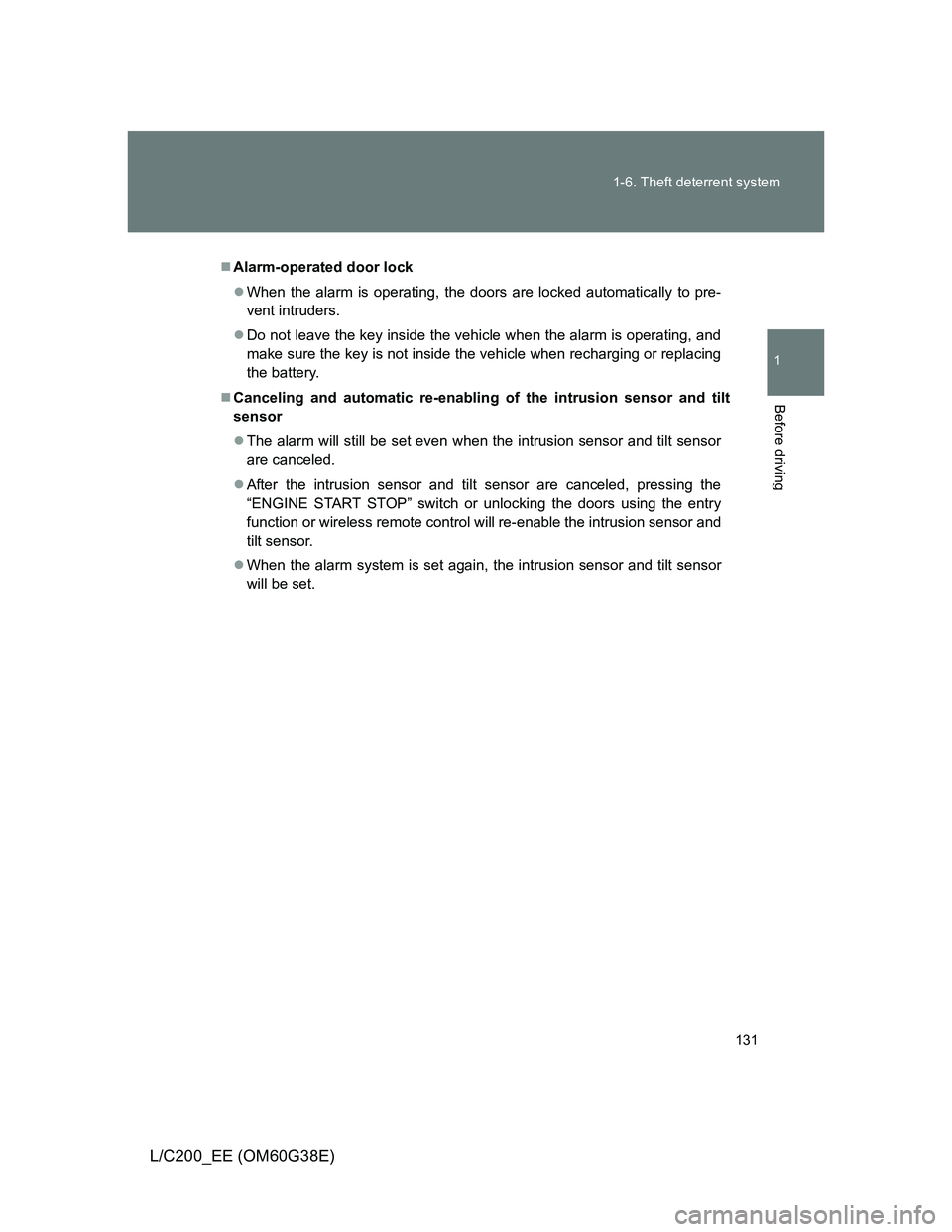
131 1-6. Theft deterrent system
1
Before driving
L/C200_EE (OM60G38E)
Alarm-operated door lock
When the alarm is operating, the doors are locked automatically to pre-
vent intruders.
Do not leave the key inside the vehicle when the alarm is operating, and
make sure the key is not inside the vehicle when recharging or replacing
the battery.
Canceling and automatic re-enabling of the intrusion sensor and tilt
sensor
The alarm will still be set even when the intrusion sensor and tilt sensor
are canceled.
After the intrusion sensor and tilt sensor are canceled, pressing the
“ENGINE START STOP” switch or unlocking the doors using the entry
function or wireless remote control will re-enable the intrusion sensor and
tilt sensor.
When the alarm system is set again, the intrusion sensor and tilt sensor
will be set.
Page 132 of 692
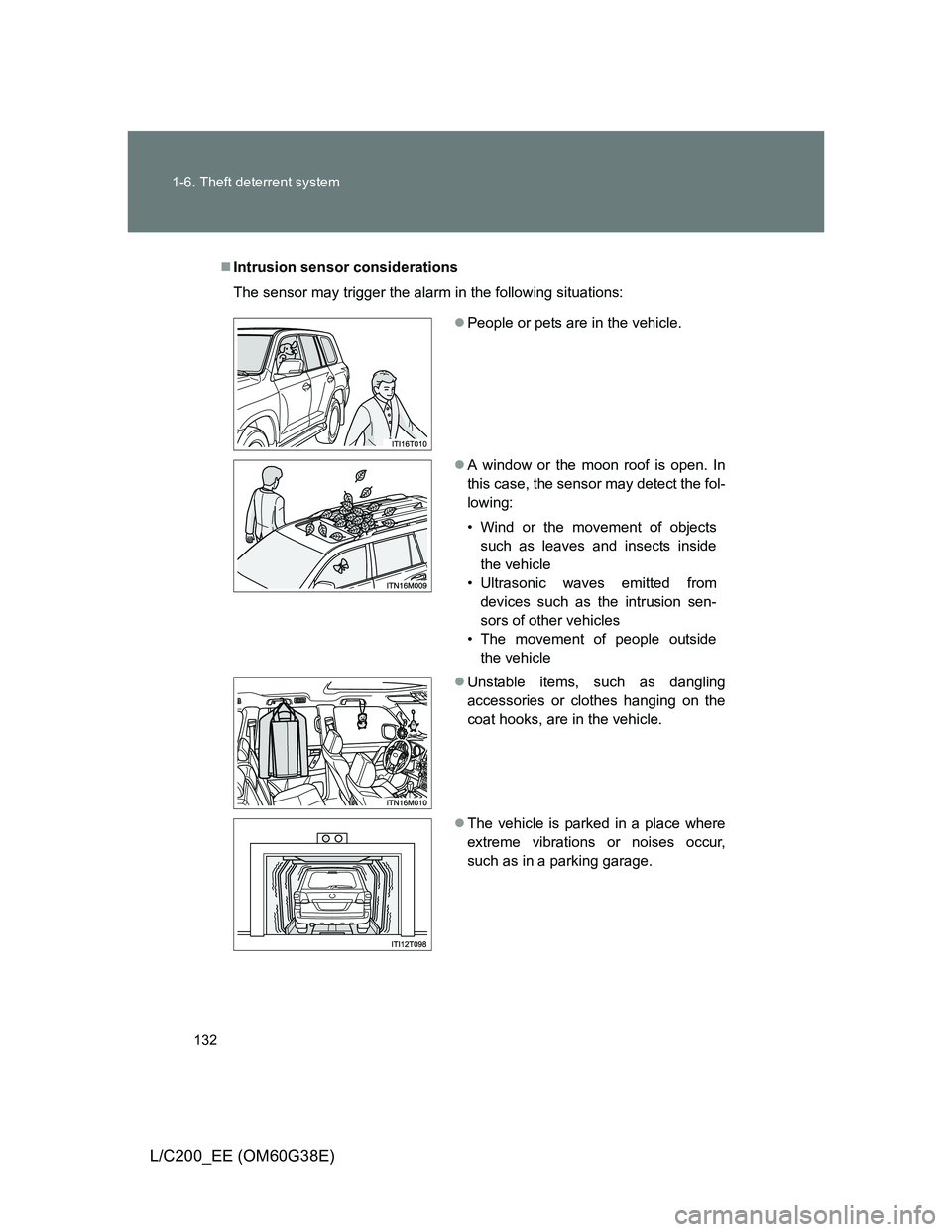
132 1-6. Theft deterrent system
L/C200_EE (OM60G38E)
Intrusion sensor considerations
The sensor may trigger the alarm in the following situations:
People or pets are in the vehicle.
A window or the moon roof is open. In
this case, the sensor may detect the fol-
lowing:
• Wind or the movement of objects
such as leaves and insects inside
the vehicle
• Ultrasonic waves emitted from
devices such as the intrusion sen-
sors of other vehicles
• The movement of people outside
the vehicle
Unstable items, such as dangling
accessories or clothes hanging on the
coat hooks, are in the vehicle.
The vehicle is parked in a place where
extreme vibrations or noises occur,
such as in a parking garage.
Page 133 of 692
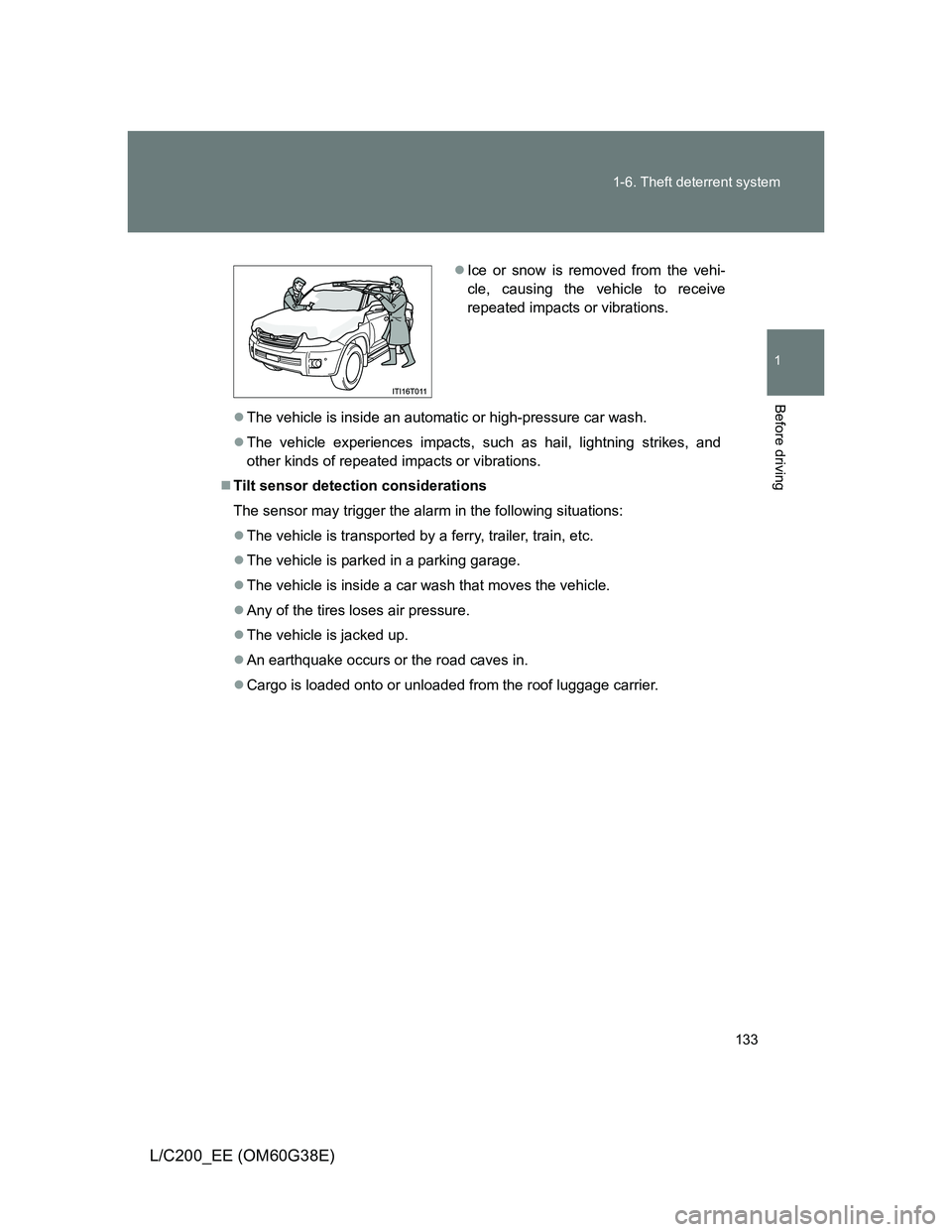
133 1-6. Theft deterrent system
1
Before driving
L/C200_EE (OM60G38E)
The vehicle is inside an automatic or high-pressure car wash.
The vehicle experiences impacts, such as hail, lightning strikes, and
other kinds of repeated impacts or vibrations.
Tilt sensor detection considerations
The sensor may trigger the alarm in the following situations:
The vehicle is transported by a ferry, trailer, train, etc.
The vehicle is parked in a parking garage.
The vehicle is inside a car wash that moves the vehicle.
Any of the tires loses air pressure.
The vehicle is jacked up.
An earthquake occurs or the road caves in.
Cargo is loaded onto or unloaded from the roof luggage carrier.
Ice or snow is removed from the vehi-
cle, causing the vehicle to receive
repeated impacts or vibrations.
Page 134 of 692
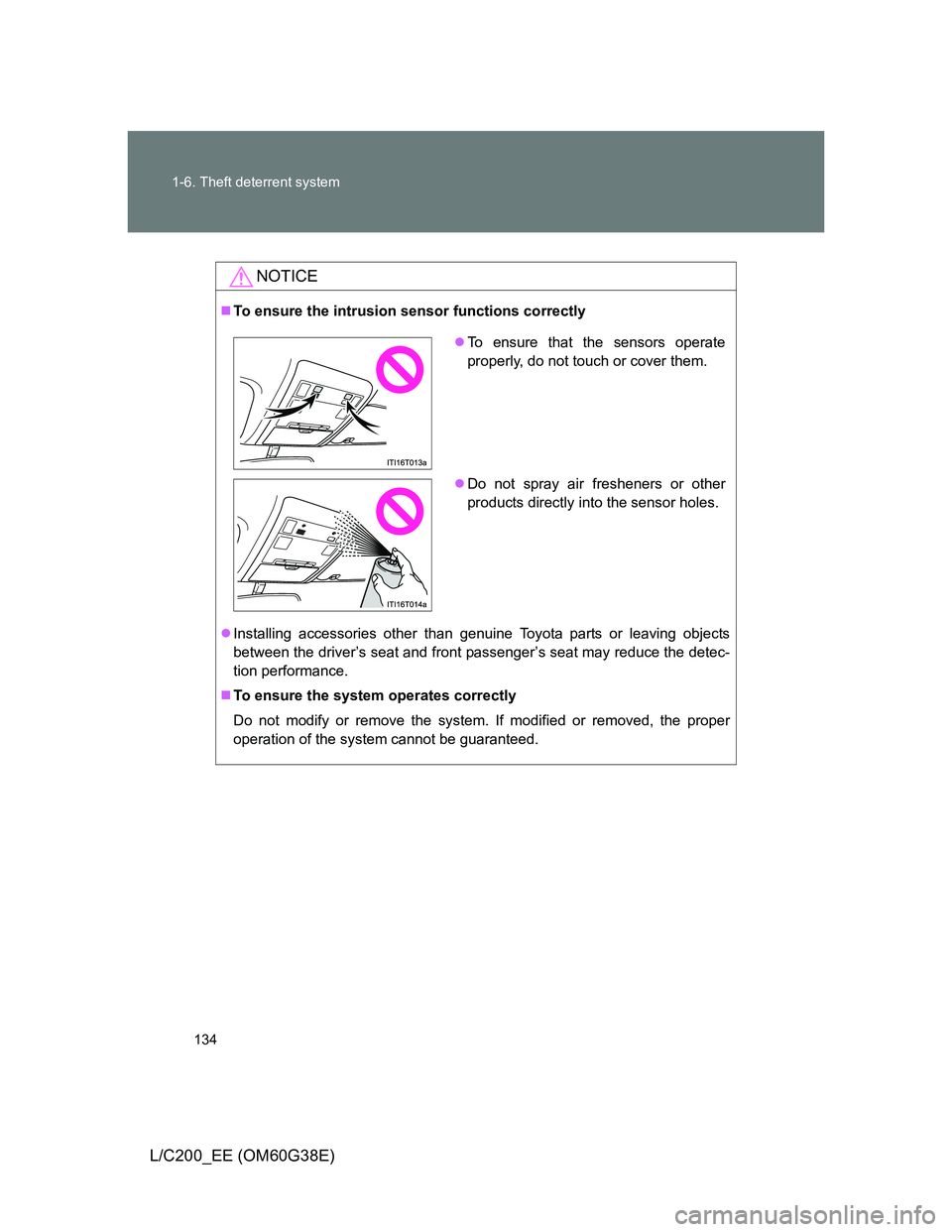
134 1-6. Theft deterrent system
L/C200_EE (OM60G38E)
NOTICE
To ensure the intrusion sensor functions correctly
Installing accessories other than genuine Toyota parts or leaving objects
between the driver’s seat and front passenger’s seat may reduce the detec-
tion performance.
To ensure the system operates correctly
Do not modify or remove the system. If modified or removed, the proper
operation of the system cannot be guaranteed.
To ensure that the sensors operate
properly, do not touch or cover them.
Do not spray air fresheners or other
products directly into the sensor holes.
Page 135 of 692

135
1
Before driving
L/C200_EE (OM60G38E)
1-7. Safety information
Correct driving posture
Drive with a good posture as follows:
Sit upright and well back in
the seat. (P. 7 5 )
Adjust the position of the
seat forward or backward to
ensure the pedals can be
reached and easily
depressed to the extent
required. (P. 75)
Adjust the seatback so that
the controls are easily oper-
able.
Adjust the tilt and telescopic
positions of the steering
wheel downward so the air-
bag is facing your chest.
(P. 101)
Lock the head restraint in
place with the center of the
head restraint closest to the
top of your ears. (P. 91)
Wear the seat belt correctly.
(P. 95)
ITY17C002
Page 136 of 692
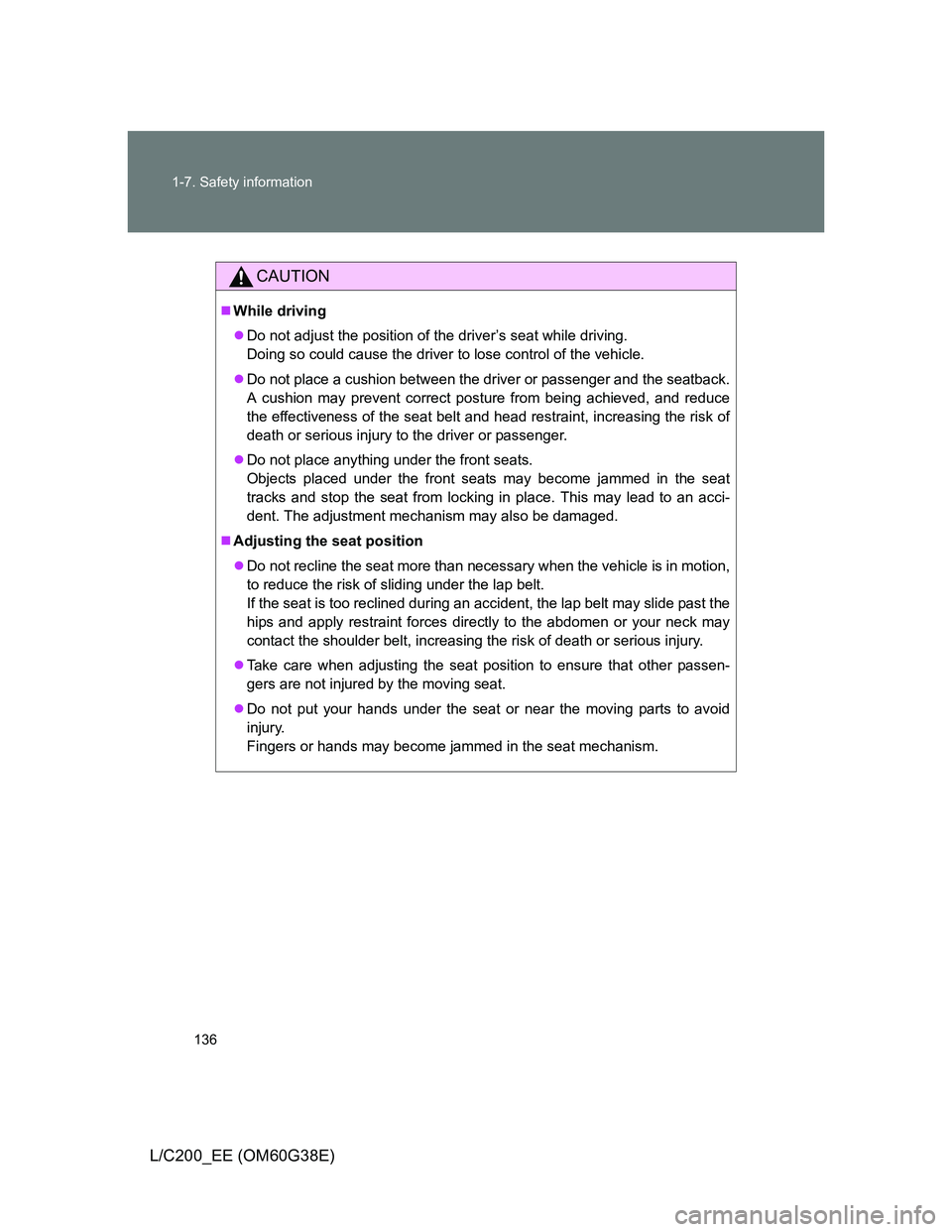
136 1-7. Safety information
L/C200_EE (OM60G38E)
CAUTION
While driving
Do not adjust the position of the driver’s seat while driving.
Doing so could cause the driver to lose control of the vehicle.
Do not place a cushion between the driver or passenger and the seatback.
A cushion may prevent correct posture from being achieved, and reduce
the effectiveness of the seat belt and head restraint, increasing the risk of
death or serious injury to the driver or passenger.
Do not place anything under the front seats.
Objects placed under the front seats may become jammed in the seat
tracks and stop the seat from locking in place. This may lead to an acci-
dent. The adjustment mechanism may also be damaged.
Adjusting the seat position
Do not recline the seat more than necessary when the vehicle is in motion,
to reduce the risk of sliding under the lap belt.
If the seat is too reclined during an accident, the lap belt may slide past the
hips and apply restraint forces directly to the abdomen or your neck may
contact the shoulder belt, increasing the risk of death or serious injury.
Take care when adjusting the seat position to ensure that other passen-
gers are not injured by the moving seat.
Do not put your hands under the seat or near the moving parts to avoid
injury.
Fingers or hands may become jammed in the seat mechanism.
Page 137 of 692
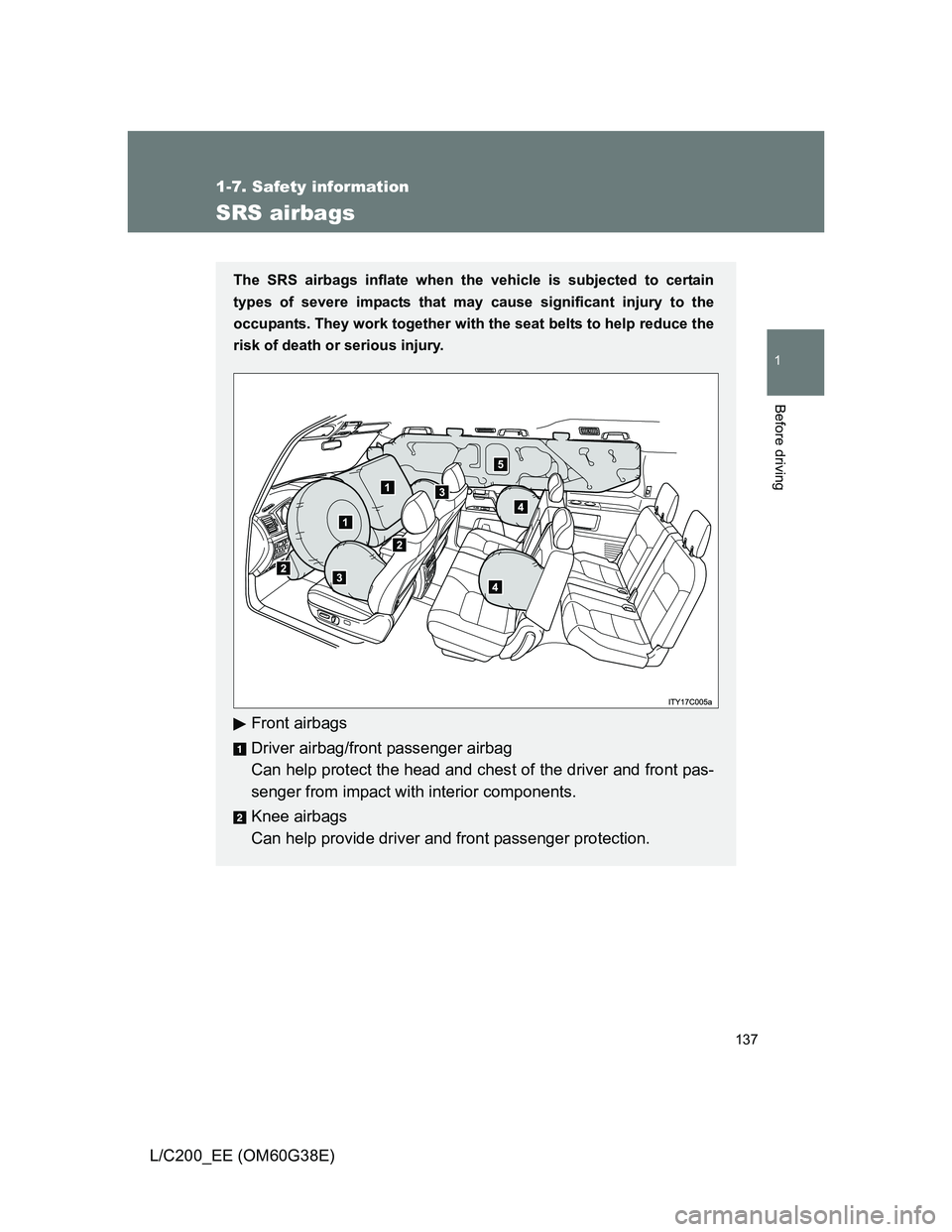
137
1
1-7. Safety information
Before driving
L/C200_EE (OM60G38E)
SRS airbags
The SRS airbags inflate when the vehicle is subjected to certain
types of severe impacts that may cause significant injury to the
occupants. They work together with the seat belts to help reduce the
risk of death or serious injury.
Front airbags
Driver airbag/front passenger airbag
Can help protect the head and chest of the driver and front pas-
senger from impact with interior components.
Knee airbags
Can help provide driver and front passenger protection.
Page 138 of 692
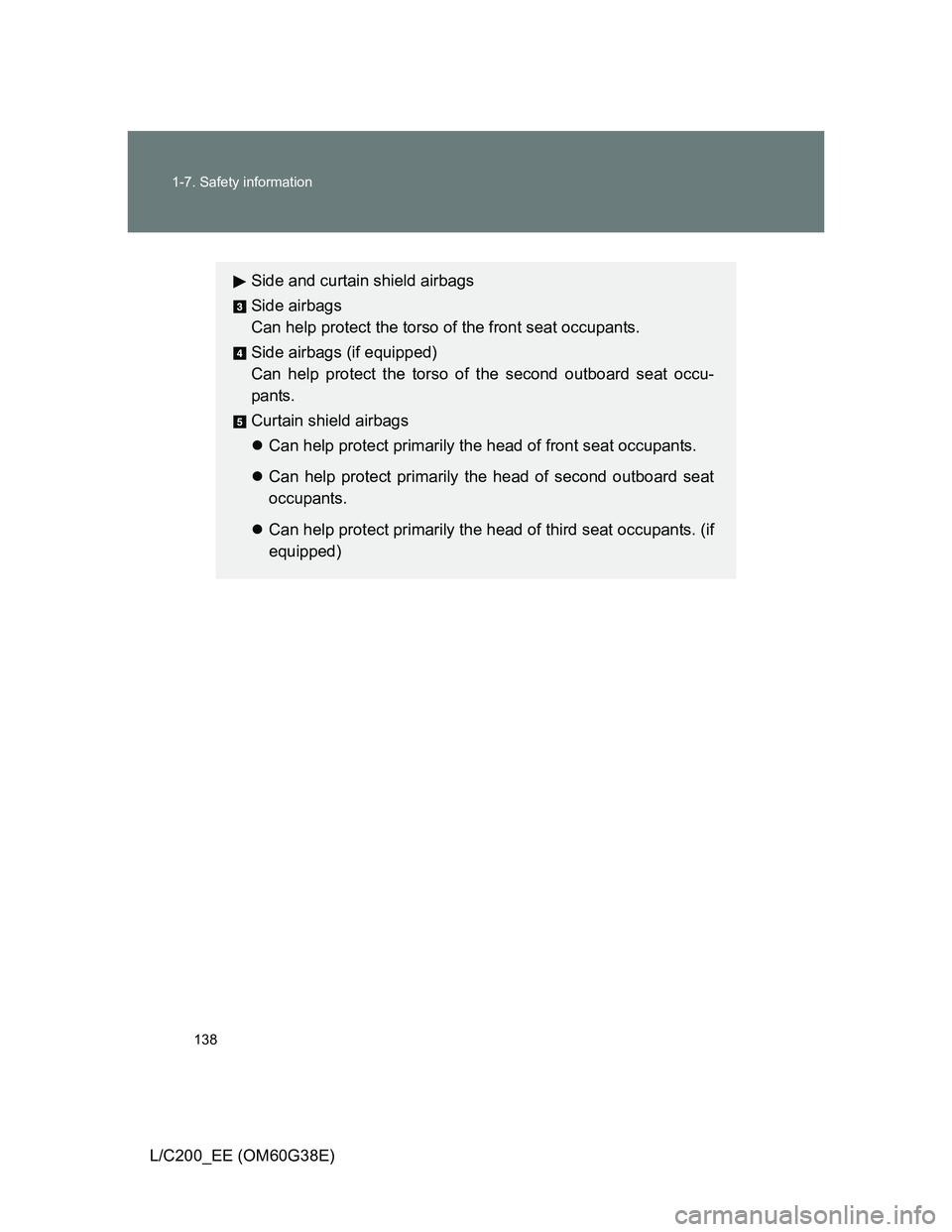
138 1-7. Safety information
L/C200_EE (OM60G38E)
Side and curtain shield airbags
Side airbags
Can help protect the torso of the front seat occupants.
Side airbags (if equipped)
Can help protect the torso of the second outboard seat occu-
pants.
Curtain shield airbags
Can help protect primarily the head of front seat occupants.
Can help protect primarily the head of second outboard seat
occupants.
Can help protect primarily the head of third seat occupants. (if
equipped)
Page 139 of 692
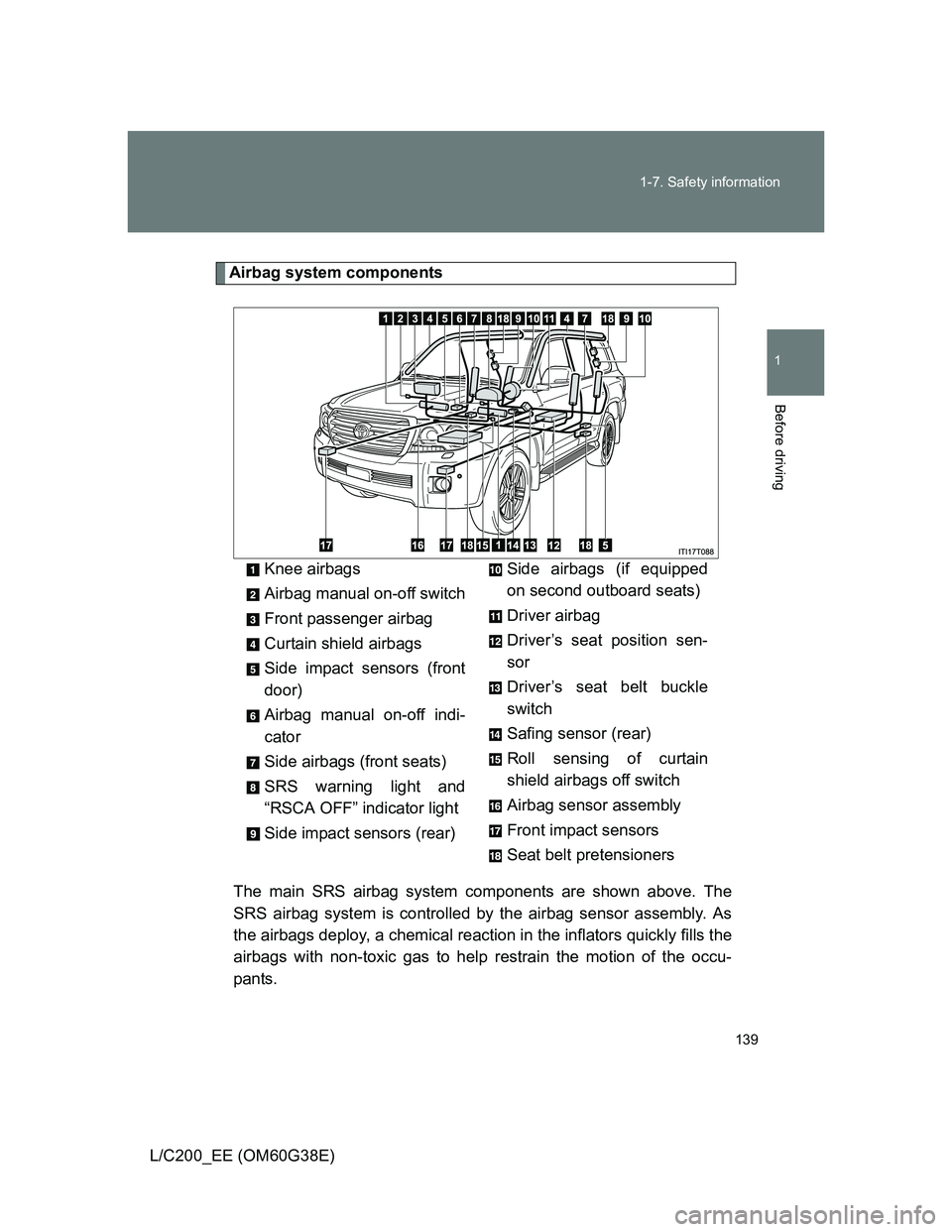
139 1-7. Safety information
1
Before driving
L/C200_EE (OM60G38E)
Airbag system components
The main SRS airbag system components are shown above. The
SRS airbag system is controlled by the airbag sensor assembly. As
the airbags deploy, a chemical reaction in the inflators quickly fills the
airbags with non-toxic gas to help restrain the motion of the occu-
pants.Knee airbags
Airbag manual on-off switch
Front passenger airbag
Curtain shield airbags
Side impact sensors (front
door)
Airbag manual on-off indi-
cator
Side airbags (front seats)
SRS warning light and
“RSCA OFF” indicator light
Side impact sensors (rear)Side airbags (if equipped
on second outboard seats)
Driver airbag
Driver’s seat position sen-
sor
Driver’s seat belt buckle
switch
Safing sensor (rear)
Roll sensing of curtain
shield airbags off switch
Airbag sensor assembly
Front impact sensors
Seat belt pretensioners
Page 140 of 692
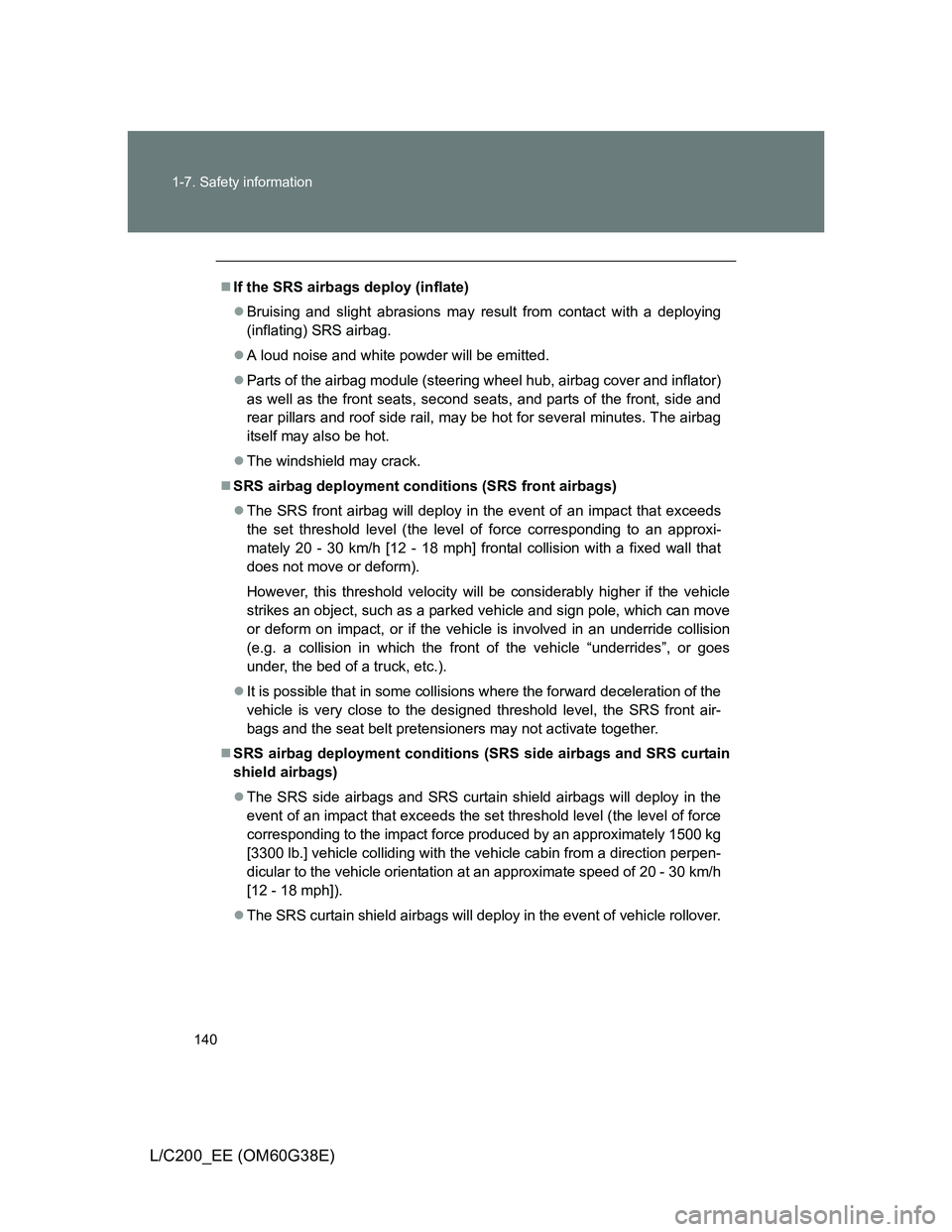
140 1-7. Safety information
L/C200_EE (OM60G38E)
If the SRS airbags deploy (inflate)
Bruising and slight abrasions may result from contact with a deploying
(inflating) SRS airbag.
A loud noise and white powder will be emitted.
Parts of the airbag module (steering wheel hub, airbag cover and inflator)
as well as the front seats, second seats, and parts of the front, side and
rear pillars and roof side rail, may be hot for several minutes. The airbag
itself may also be hot.
The windshield may crack.
SRS airbag deployment conditions (SRS front airbags)
The SRS front airbag will deploy in the event of an impact that exceeds
the set threshold level (the level of force corresponding to an approxi-
mately 20 - 30 km/h [12 - 18 mph] frontal collision with a fixed wall that
does not move or deform).
However, this threshold velocity will be considerably higher if the vehicle
strikes an object, such as a parked vehicle and sign pole, which can move
or deform on impact, or if the vehicle is involved in an underride collision
(e.g. a collision in which the front of the vehicle “underrides”, or goes
under, the bed of a truck, etc.).
It is possible that in some collisions where the forward deceleration of the
vehicle is very close to the designed threshold level, the SRS front air-
bags and the seat belt pretensioners may not activate together.
SRS airbag deployment conditions (SRS side airbags and SRS curtain
shield airbags)
The SRS side airbags and SRS curtain shield airbags will deploy in the
event of an impact that exceeds the set threshold level (the level of force
corresponding to the impact force produced by an approximately 1500 kg
[3300 lb.] vehicle colliding with the vehicle cabin from a direction perpen-
dicular to the vehicle orientation at an approximate speed of 20 - 30 km/h
[12 - 18 mph]).
The SRS curtain shield airbags will deploy in the event of vehicle rollover.